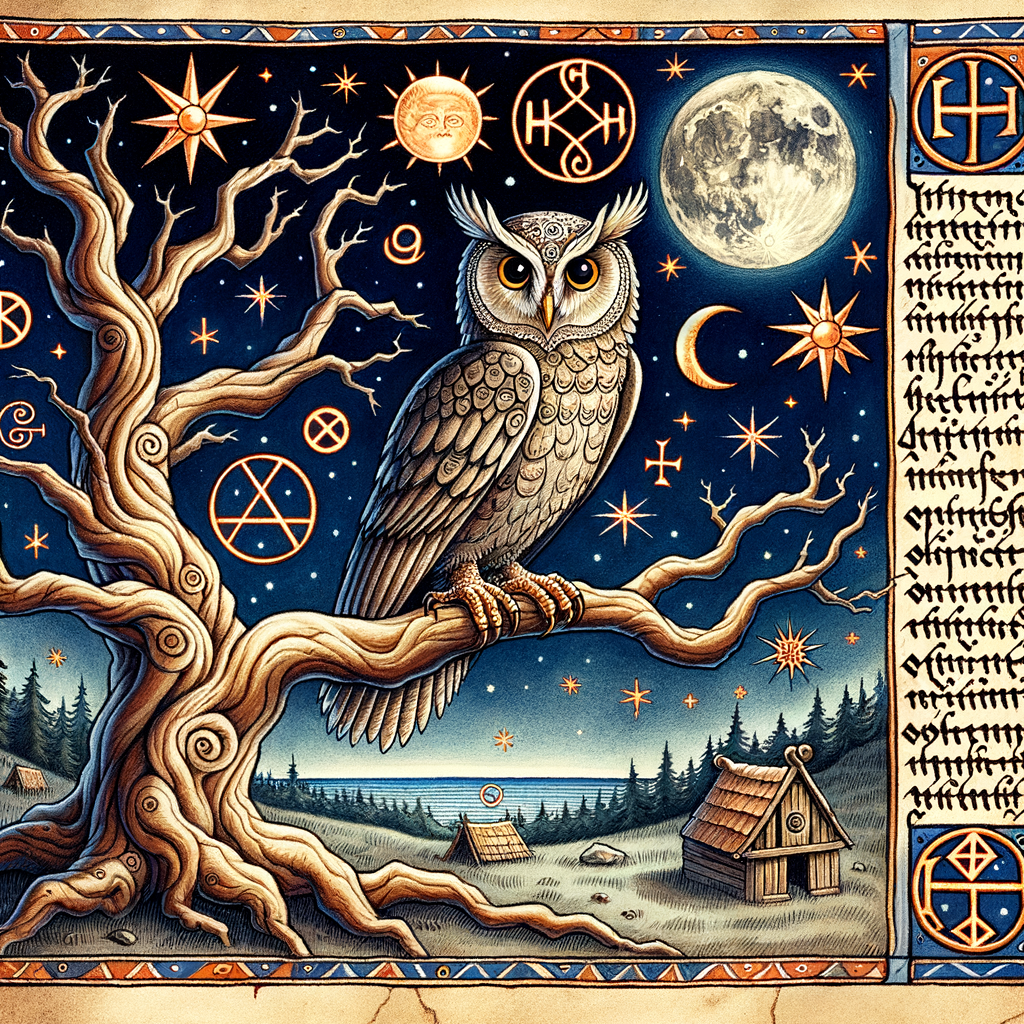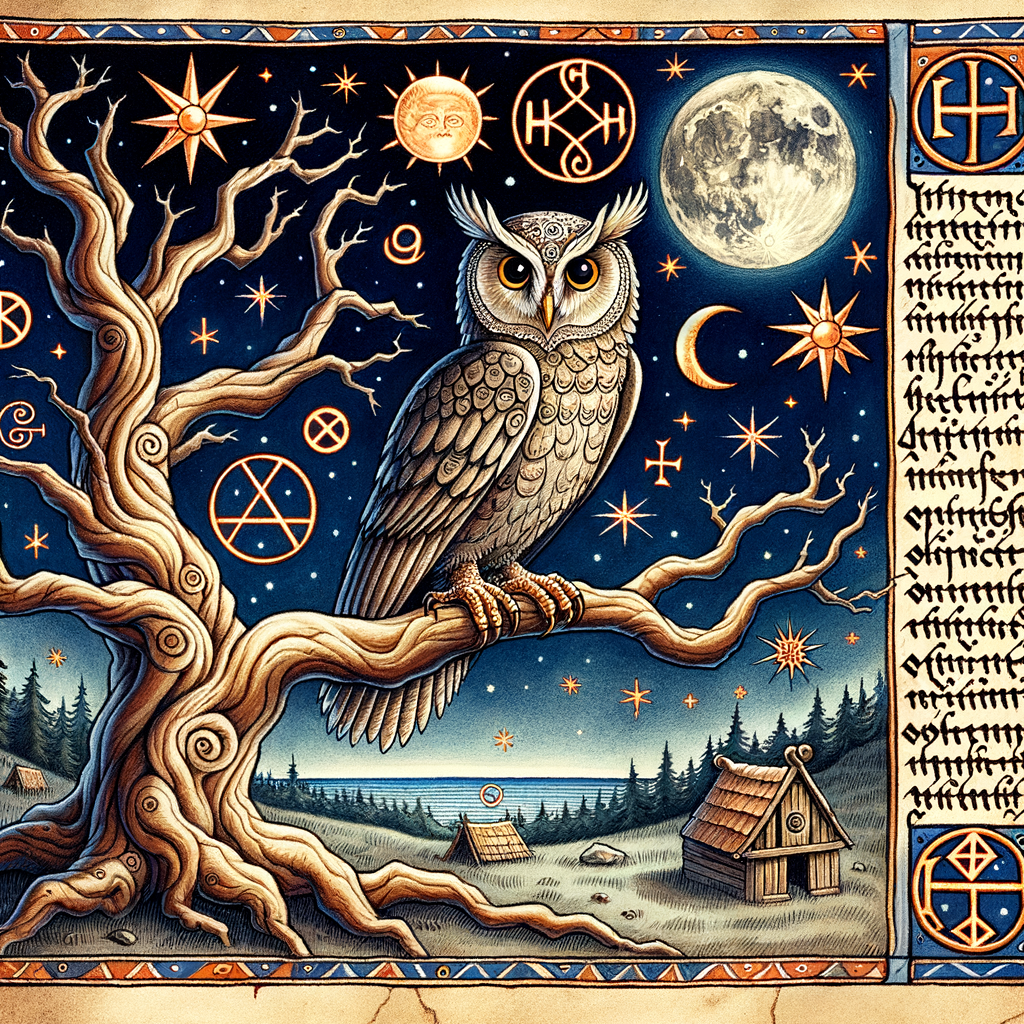
Introduction to Owls in Medieval Mythology
- Overview of the role of owls in medieval folklore: Owls have always been fascinating creatures. In medieval times, they were seen as mysterious and magical. People believed that owls had special powers. They thought owls could see what others could not. This made owls important in many stories and legends.
- Importance of owls in medieval culture: Owls were more than just birds in medieval culture. They were symbols of wisdom and knowledge. Many people thought that owls could bring good luck or bad luck, depending on the situation. Because of this, owls were often featured in art, literature, and even in coats of arms.
Medieval Owl Symbolism
General Symbolism
- Symbol of wisdom and knowledge: In medieval times, owls were often seen as wise creatures. People believed that owls had a deep understanding of the world. They were thought to be very smart and full of knowledge.
- Association with the night and darkness: Owls are nocturnal, meaning they are active at night. Because of this, they were linked to the night and darkness. Many stories and myths from the medieval period talk about owls as mysterious night creatures.
Symbolism in Different Cultures
-
Owls in European Folklore
Owls are often seen as symbols of wisdom. This belief comes from ancient Greece, where the owl was the sacred bird of Athena, the goddess of wisdom. People believed that seeing an owl was a sign of good fortune and knowledge.
However, not all European cultures viewed owls positively. In some parts of Europe, owls were thought to be omens of death. For example, in Medieval England, hearing an owl hoot was considered a bad sign.
-
Owls in Middle Eastern Folklore
In some stories, they are seen as protectors. For instance, in ancient Persia, owls were thought to guard treasures and sacred places.
On the other hand, some Middle Eastern tales view owls as messengers of bad news. In Arabian folklore, an owl’s call was sometimes believed to bring bad luck or even death.
-
Owls in Asian Folklore
In Asia, the symbolism of owls varies widely. In Japan, owls are considered lucky and are symbols of good fortune. The Japanese word for owl, “fukurou,” also means “no hardship,” making it a positive symbol.
In contrast, in some parts of China, owls are seen as omens of bad luck. They are sometimes associated with death and misfortune. However, in other Chinese traditions, owls are seen as protectors of the home.
Folklore About Owls
Common Folktales
- Folktales involving owls as omens:Some believe that if an owl hoots near your home, it might bring bad news. For example, in medieval Europe, people thought that hearing an owl’s hoot meant someone would fall ill or even die. This belief made owls both feared and respected.
- Stories of owls as protectors:Not all stories about owls are scary. In some tales, owls are protectors. For instance, in Greek mythology, the owl was a symbol of Athena, the goddess of wisdom. People believed that seeing an owl meant Athena was watching over them. This made owls symbols of protection and guidance.
Myths and Legends
-
Owl Myths in the Middle Ages
Owls were often seen as mysterious creatures. People believed that owls had special powers. Some thought that owls could predict the future. Others believed that owls were messengers from the spirit world.
In many stories, owls were linked to witches and wizards. They were thought to be their companions. This made owls both feared and respected. For example, in some tales, an owl’s hoot was a sign that something bad was about to happen.
-
Legends Involving Owls and Magic
In ancient stories, owls were often seen as wise and magical creatures. They were believed to have the power to see things that others could not.
One famous legend is about the owl and the moon. It was said that owls could talk to the moon and gain secret knowledge. This made them symbols of wisdom and mystery. In some cultures, people believed that owls could help them with spells and potions.
Medieval Superstitions About Owls
- Beliefs about owls and death: In medieval times, many people thought that owls were a sign of death. If someone saw an owl, they believed it meant someone nearby would soon die. This belief was so strong that people often feared hearing an owl’s hoot at night.
- Superstitions about owls and bad luck: Owls were also seen as bringers of bad luck. People thought that if an owl flew over their house, it would bring misfortune. Some even believed that owls could cast evil spells. Because of these superstitions, owls were often seen as creatures to be avoided.
Historical Beliefs About Owls
Beliefs in Different Regions
-
Beliefs about owls in Western Europe:
Many people believed that owls had special powers to see what others could not. For example, in ancient Greece, the owl was associated with Athena, the goddess of wisdom. However, during the medieval period, the perception shifted. Owls were sometimes thought to be omens of death or bad luck. This change in belief was influenced by the dark and mysterious nature of owls, which made them seem spooky to people of that time.
-
Beliefs about owls in Eastern Europe:
In Eastern Europe, owls were often linked to folklore and superstitions. Many stories depicted owls as protectors of the night, guarding against evil spirits. In some cultures, it was believed that owls could communicate with the dead or serve as messengers from the spirit world. For instance, in Slavic mythology, the owl was seen as a guide for souls traveling to the afterlife. Despite these positive aspects, there were also negative beliefs. Some thought that hearing an owl’s hoot was a sign of impending misfortune or even death.
Changes in Beliefs Over Time
-
Shifts in Owl Symbolism from the Middle Ages to the Renaissance
During the Middle Ages, owls were often seen as symbols of death and bad luck. People believed that seeing an owl meant something terrible was about to happen. This belief was common in many parts of Europe.
However, during the Renaissance, people’s views on owls began to change. The Renaissance was a time of learning and discovery. People started to see owls as wise and knowledgeable creatures. This shift happened because of the Renaissance’s focus on education and the natural world.
For example, in art and literature from the Renaissance, owls are often shown as companions to scholars and wise people. This change in symbolism shows how people’s beliefs can evolve over time.
-
Modern Perceptions of Owls Compared to Medieval Beliefs
Today, owls are mostly seen in a positive light. Many people think of owls as symbols of wisdom and knowledge. This is very different from the medieval belief that owls were bad omens.
One reason for this change is that we now know more about owls and their behavior. Modern science has helped us understand that owls are important for controlling pests like mice and insects. This makes them helpful animals rather than scary ones.
Additionally, owls are popular in modern culture. They appear in movies, books, and even as mascots for schools. This positive portrayal helps shape our current views of owls.
Here is a table that summarizes the changes in owl symbolism over time:
Time Period Symbolism Middle Ages Death, Bad Luck Renaissance Wisdom, Knowledge Modern Times Wisdom, Helpfulness
Cultural Significance of Owls in Medieval Times
-
Owls in Medieval Art and Literature
Artists used owls to symbolize wisdom and mystery. In many paintings, you can see owls perched beside scholars or in dark forests. Writers also included owls in their stories and poems. They were seen as creatures of the night, often linked to secrets and hidden knowledge.
-
Role of Owls in Medieval Religious Beliefs
Some people thought owls were messengers from the spiritual world. They believed that seeing an owl could be a sign from God or a warning of something important. Monks and priests sometimes used owl imagery in their teachings to explain complex ideas about life and death.
Conclusion: Owls as Guardians of the Night
- Summary of the importance of owls in medieval folklore: Owls played a crucial role in medieval folklore. They were often seen as mysterious and wise creatures. People believed that owls had special powers and could see what others could not. This made them symbols of knowledge and protection in the dark.
- Continuing influence of owl symbolism today: Even today, owls continue to be powerful symbols. They are often used to represent wisdom and mystery in books, movies, and art. Many cultures still see owls as protectors of the night, keeping watch while others sleep.
| Aspect | Medieval Times | Modern Times |
|---|---|---|
| Symbolism | Wisdom, Mystery, Protection | Wisdom, Mystery, Protection |
| Role in Folklore | Guardians of the Night | Popular in Media and Art |
Owls have always been fascinating creatures. Their role as guardians of the night in medieval folklore has left a lasting impact. Today, they continue to be symbols of wisdom and mystery, showing how powerful and enduring these ancient beliefs are.






